Evaluating E-commerce Impact on Retail Performance: Marks and Spencer
VerifiedAdded on 2022/12/27
|10
|2530
|1
Report
AI Summary
This report presents a comprehensive analysis of the impact of e-commerce strategies on the performance management of Marks and Spencer, a major UK-based multinational retailer. The study investigates the evolution of e-commerce and its significance within the retail sector, emphasizing its role in enhancing productivity, sales, and customer engagement. The research employs a positivism philosophy, deductive approach, and descriptive research design, utilizing both quantitative and qualitative research methods to assess the impact of e-commerce strategies. The methodology includes a survey strategy with a questionnaire distributed among 45 employees of Marks and Spencer, supplemented by secondary data from online articles and journals. The report aims to evaluate the influence of e-commerce on business performance, identify effective e-commerce strategies for improved growth, and offer recommendations for Marks and Spencer to enhance its performance management through the adoption of advanced e-commerce approaches. The research also addresses ethical considerations and provides a detailed timescale and resource allocation for the investigation.

Proposal and Ethics
Form
1
Form
1
Paraphrase This Document
Need a fresh take? Get an instant paraphrase of this document with our AI Paraphraser
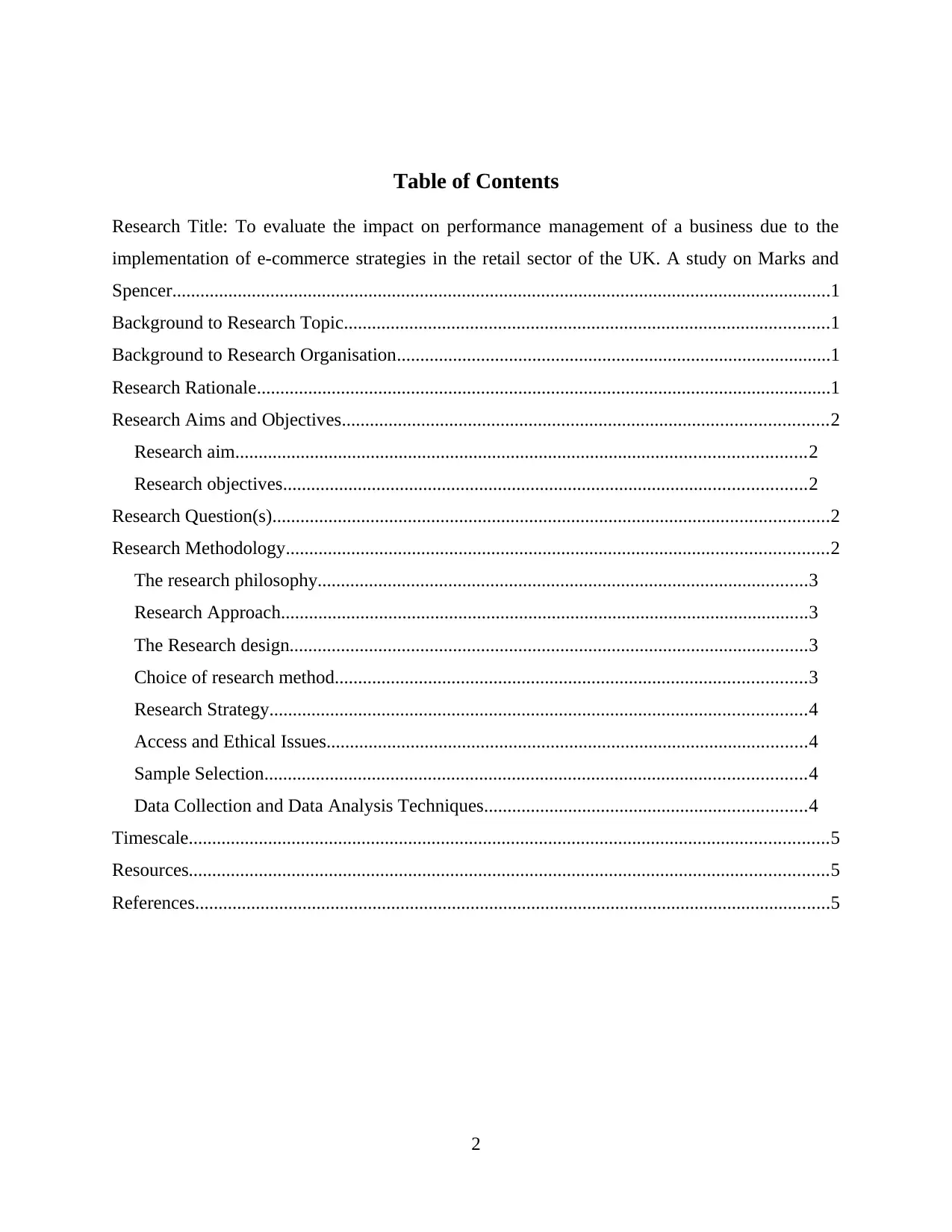
Table of Contents
Research Title: To evaluate the impact on performance management of a business due to the
implementation of e-commerce strategies in the retail sector of the UK. A study on Marks and
Spencer.............................................................................................................................................1
Background to Research Topic........................................................................................................1
Background to Research Organisation.............................................................................................1
Research Rationale...........................................................................................................................1
Research Aims and Objectives........................................................................................................2
Research aim..........................................................................................................................2
Research objectives................................................................................................................2
Research Question(s).......................................................................................................................2
Research Methodology....................................................................................................................2
The research philosophy.........................................................................................................3
Research Approach.................................................................................................................3
The Research design...............................................................................................................3
Choice of research method.....................................................................................................3
Research Strategy...................................................................................................................4
Access and Ethical Issues.......................................................................................................4
Sample Selection....................................................................................................................4
Data Collection and Data Analysis Techniques.....................................................................4
Timescale.........................................................................................................................................5
Resources.........................................................................................................................................5
References........................................................................................................................................5
2
Research Title: To evaluate the impact on performance management of a business due to the
implementation of e-commerce strategies in the retail sector of the UK. A study on Marks and
Spencer.............................................................................................................................................1
Background to Research Topic........................................................................................................1
Background to Research Organisation.............................................................................................1
Research Rationale...........................................................................................................................1
Research Aims and Objectives........................................................................................................2
Research aim..........................................................................................................................2
Research objectives................................................................................................................2
Research Question(s).......................................................................................................................2
Research Methodology....................................................................................................................2
The research philosophy.........................................................................................................3
Research Approach.................................................................................................................3
The Research design...............................................................................................................3
Choice of research method.....................................................................................................3
Research Strategy...................................................................................................................4
Access and Ethical Issues.......................................................................................................4
Sample Selection....................................................................................................................4
Data Collection and Data Analysis Techniques.....................................................................4
Timescale.........................................................................................................................................5
Resources.........................................................................................................................................5
References........................................................................................................................................5
2
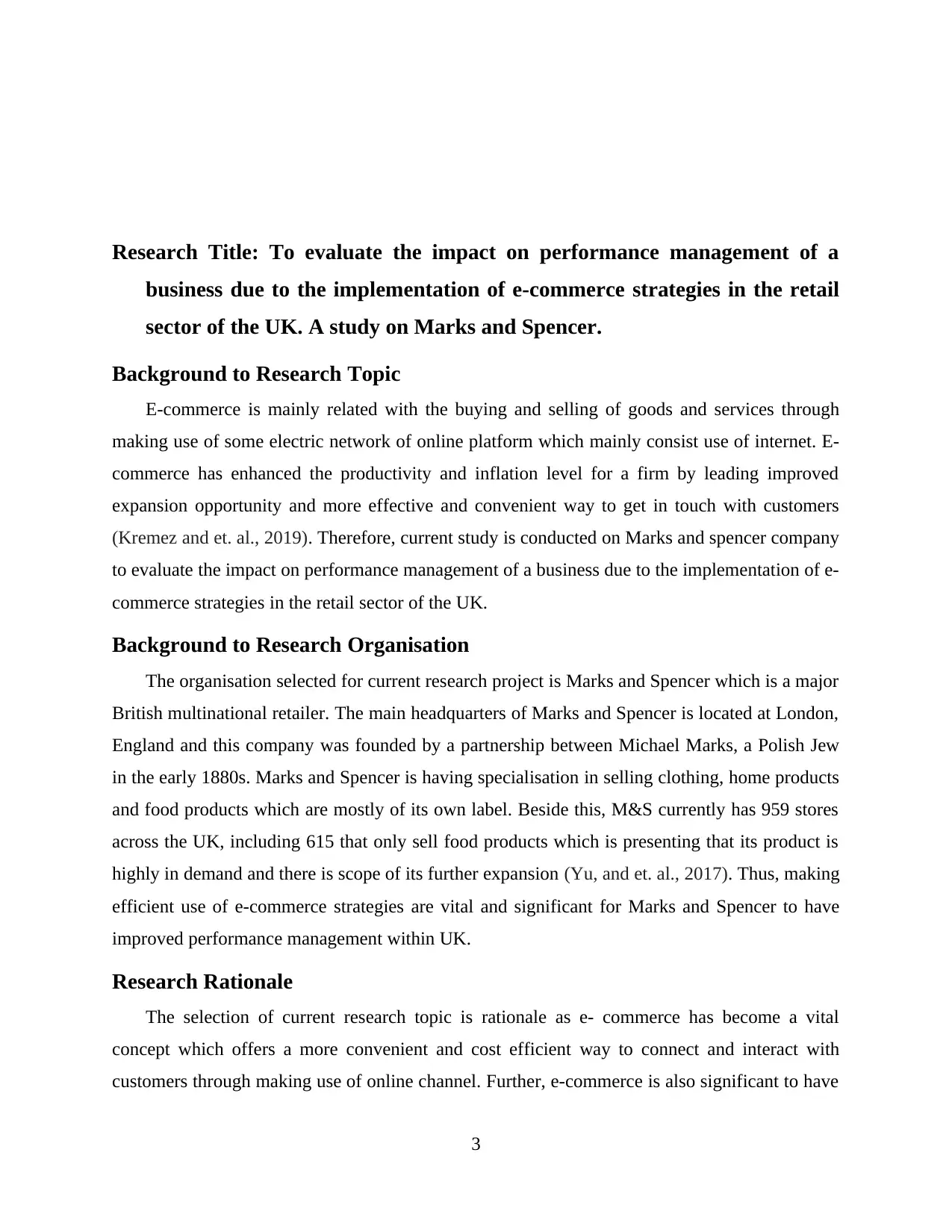
Research Title: To evaluate the impact on performance management of a
business due to the implementation of e-commerce strategies in the retail
sector of the UK. A study on Marks and Spencer.
Background to Research Topic
E-commerce is mainly related with the buying and selling of goods and services through
making use of some electric network of online platform which mainly consist use of internet. E-
commerce has enhanced the productivity and inflation level for a firm by leading improved
expansion opportunity and more effective and convenient way to get in touch with customers
(Kremez and et. al., 2019). Therefore, current study is conducted on Marks and spencer company
to evaluate the impact on performance management of a business due to the implementation of e-
commerce strategies in the retail sector of the UK.
Background to Research Organisation
The organisation selected for current research project is Marks and Spencer which is a major
British multinational retailer. The main headquarters of Marks and Spencer is located at London,
England and this company was founded by a partnership between Michael Marks, a Polish Jew
in the early 1880s. Marks and Spencer is having specialisation in selling clothing, home products
and food products which are mostly of its own label. Beside this, M&S currently has 959 stores
across the UK, including 615 that only sell food products which is presenting that its product is
highly in demand and there is scope of its further expansion (Yu, and et. al., 2017). Thus, making
efficient use of e-commerce strategies are vital and significant for Marks and Spencer to have
improved performance management within UK.
Research Rationale
The selection of current research topic is rationale as e- commerce has become a vital
concept which offers a more convenient and cost efficient way to connect and interact with
customers through making use of online channel. Further, e-commerce is also significant to have
3
business due to the implementation of e-commerce strategies in the retail
sector of the UK. A study on Marks and Spencer.
Background to Research Topic
E-commerce is mainly related with the buying and selling of goods and services through
making use of some electric network of online platform which mainly consist use of internet. E-
commerce has enhanced the productivity and inflation level for a firm by leading improved
expansion opportunity and more effective and convenient way to get in touch with customers
(Kremez and et. al., 2019). Therefore, current study is conducted on Marks and spencer company
to evaluate the impact on performance management of a business due to the implementation of e-
commerce strategies in the retail sector of the UK.
Background to Research Organisation
The organisation selected for current research project is Marks and Spencer which is a major
British multinational retailer. The main headquarters of Marks and Spencer is located at London,
England and this company was founded by a partnership between Michael Marks, a Polish Jew
in the early 1880s. Marks and Spencer is having specialisation in selling clothing, home products
and food products which are mostly of its own label. Beside this, M&S currently has 959 stores
across the UK, including 615 that only sell food products which is presenting that its product is
highly in demand and there is scope of its further expansion (Yu, and et. al., 2017). Thus, making
efficient use of e-commerce strategies are vital and significant for Marks and Spencer to have
improved performance management within UK.
Research Rationale
The selection of current research topic is rationale as e- commerce has become a vital
concept which offers a more convenient and cost efficient way to connect and interact with
customers through making use of online channel. Further, e-commerce is also significant to have
3
⊘ This is a preview!⊘
Do you want full access?
Subscribe today to unlock all pages.

Trusted by 1+ million students worldwide
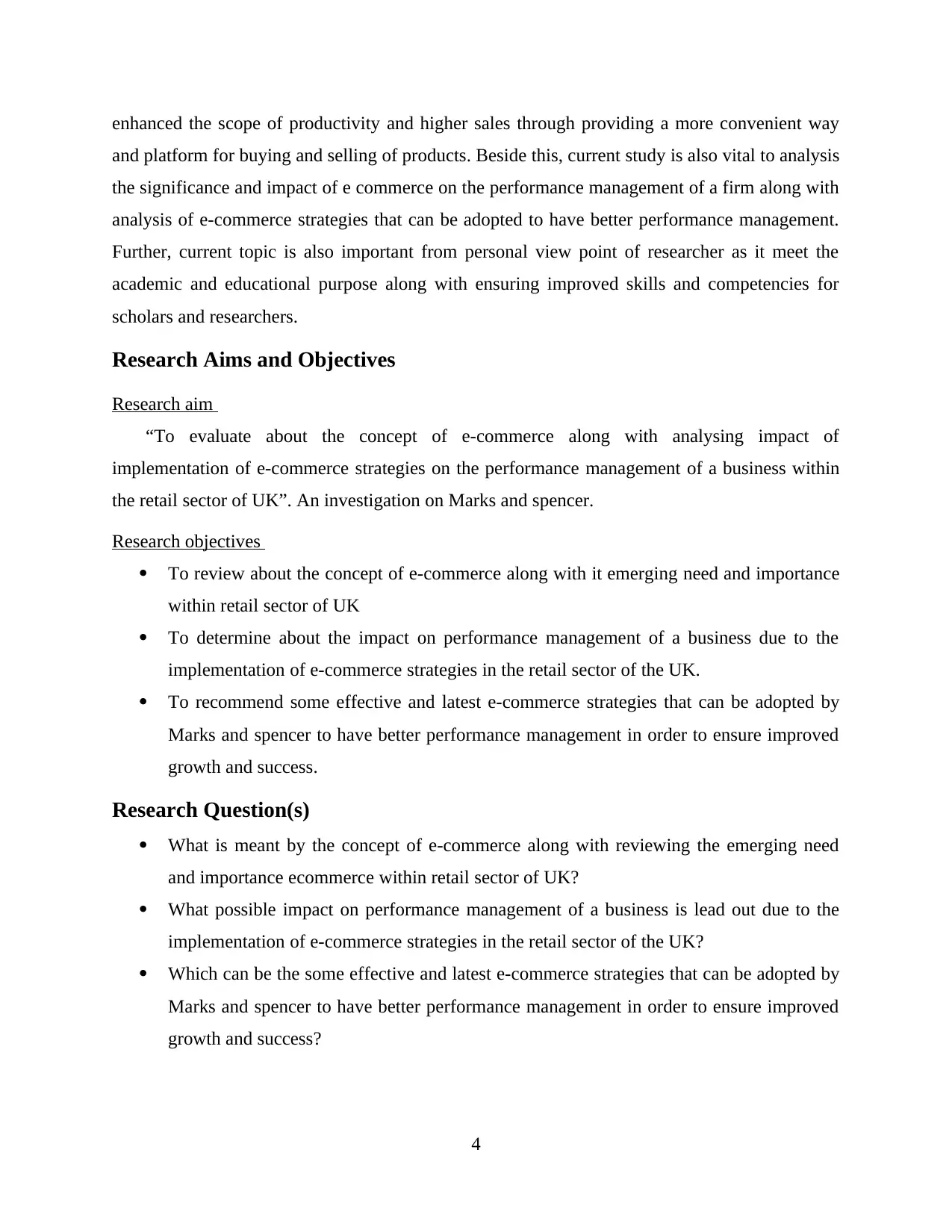
enhanced the scope of productivity and higher sales through providing a more convenient way
and platform for buying and selling of products. Beside this, current study is also vital to analysis
the significance and impact of e commerce on the performance management of a firm along with
analysis of e-commerce strategies that can be adopted to have better performance management.
Further, current topic is also important from personal view point of researcher as it meet the
academic and educational purpose along with ensuring improved skills and competencies for
scholars and researchers.
Research Aims and Objectives
Research aim
“To evaluate about the concept of e-commerce along with analysing impact of
implementation of e-commerce strategies on the performance management of a business within
the retail sector of UK”. An investigation on Marks and spencer.
Research objectives
To review about the concept of e-commerce along with it emerging need and importance
within retail sector of UK
To determine about the impact on performance management of a business due to the
implementation of e-commerce strategies in the retail sector of the UK.
To recommend some effective and latest e-commerce strategies that can be adopted by
Marks and spencer to have better performance management in order to ensure improved
growth and success.
Research Question(s)
What is meant by the concept of e-commerce along with reviewing the emerging need
and importance ecommerce within retail sector of UK?
What possible impact on performance management of a business is lead out due to the
implementation of e-commerce strategies in the retail sector of the UK?
Which can be the some effective and latest e-commerce strategies that can be adopted by
Marks and spencer to have better performance management in order to ensure improved
growth and success?
4
and platform for buying and selling of products. Beside this, current study is also vital to analysis
the significance and impact of e commerce on the performance management of a firm along with
analysis of e-commerce strategies that can be adopted to have better performance management.
Further, current topic is also important from personal view point of researcher as it meet the
academic and educational purpose along with ensuring improved skills and competencies for
scholars and researchers.
Research Aims and Objectives
Research aim
“To evaluate about the concept of e-commerce along with analysing impact of
implementation of e-commerce strategies on the performance management of a business within
the retail sector of UK”. An investigation on Marks and spencer.
Research objectives
To review about the concept of e-commerce along with it emerging need and importance
within retail sector of UK
To determine about the impact on performance management of a business due to the
implementation of e-commerce strategies in the retail sector of the UK.
To recommend some effective and latest e-commerce strategies that can be adopted by
Marks and spencer to have better performance management in order to ensure improved
growth and success.
Research Question(s)
What is meant by the concept of e-commerce along with reviewing the emerging need
and importance ecommerce within retail sector of UK?
What possible impact on performance management of a business is lead out due to the
implementation of e-commerce strategies in the retail sector of the UK?
Which can be the some effective and latest e-commerce strategies that can be adopted by
Marks and spencer to have better performance management in order to ensure improved
growth and success?
4
Paraphrase This Document
Need a fresh take? Get an instant paraphrase of this document with our AI Paraphraser
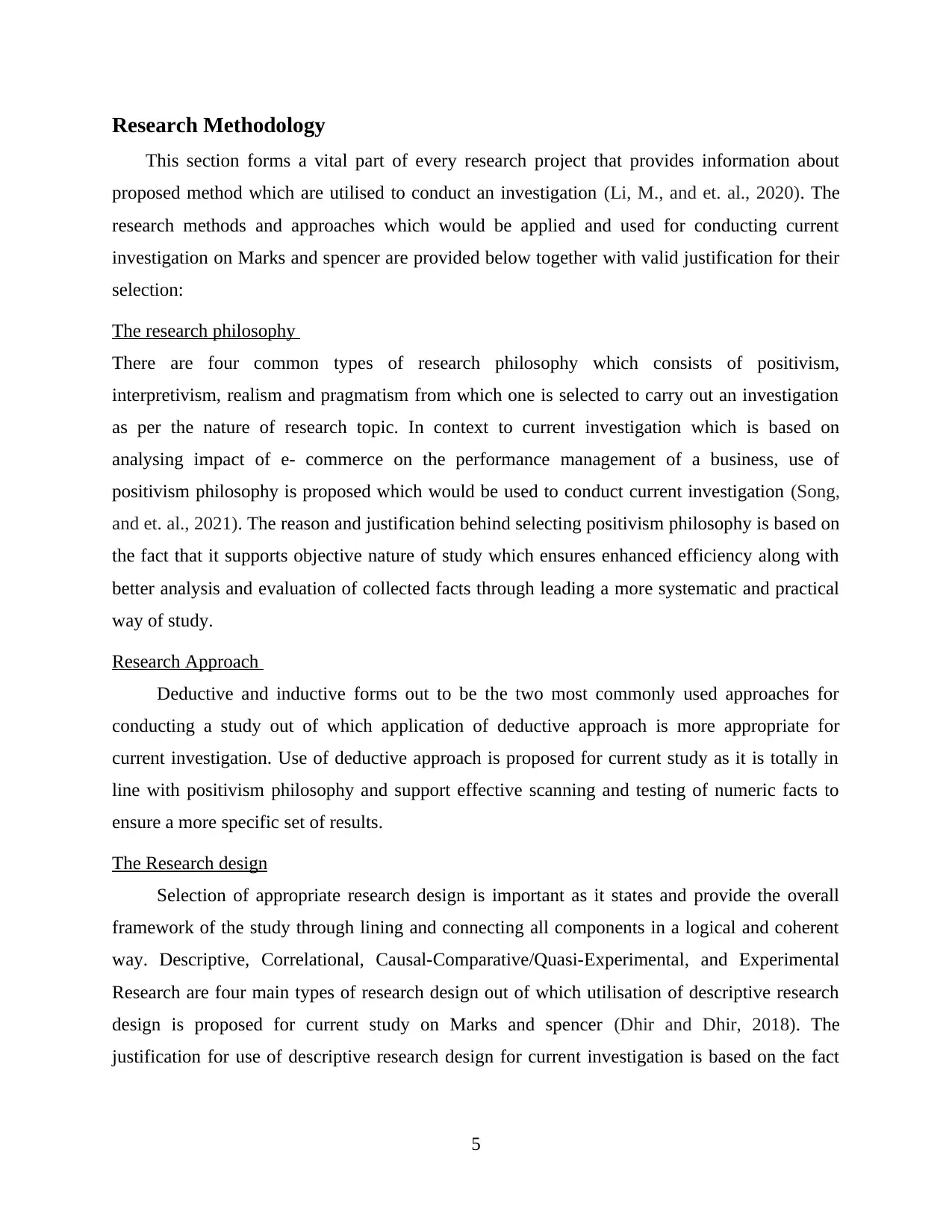
Research Methodology
This section forms a vital part of every research project that provides information about
proposed method which are utilised to conduct an investigation (Li, M., and et. al., 2020). The
research methods and approaches which would be applied and used for conducting current
investigation on Marks and spencer are provided below together with valid justification for their
selection:
The research philosophy
There are four common types of research philosophy which consists of positivism,
interpretivism, realism and pragmatism from which one is selected to carry out an investigation
as per the nature of research topic. In context to current investigation which is based on
analysing impact of e- commerce on the performance management of a business, use of
positivism philosophy is proposed which would be used to conduct current investigation (Song,
and et. al., 2021). The reason and justification behind selecting positivism philosophy is based on
the fact that it supports objective nature of study which ensures enhanced efficiency along with
better analysis and evaluation of collected facts through leading a more systematic and practical
way of study.
Research Approach
Deductive and inductive forms out to be the two most commonly used approaches for
conducting a study out of which application of deductive approach is more appropriate for
current investigation. Use of deductive approach is proposed for current study as it is totally in
line with positivism philosophy and support effective scanning and testing of numeric facts to
ensure a more specific set of results.
The Research design
Selection of appropriate research design is important as it states and provide the overall
framework of the study through lining and connecting all components in a logical and coherent
way. Descriptive, Correlational, Causal-Comparative/Quasi-Experimental, and Experimental
Research are four main types of research design out of which utilisation of descriptive research
design is proposed for current study on Marks and spencer (Dhir and Dhir, 2018). The
justification for use of descriptive research design for current investigation is based on the fact
5
This section forms a vital part of every research project that provides information about
proposed method which are utilised to conduct an investigation (Li, M., and et. al., 2020). The
research methods and approaches which would be applied and used for conducting current
investigation on Marks and spencer are provided below together with valid justification for their
selection:
The research philosophy
There are four common types of research philosophy which consists of positivism,
interpretivism, realism and pragmatism from which one is selected to carry out an investigation
as per the nature of research topic. In context to current investigation which is based on
analysing impact of e- commerce on the performance management of a business, use of
positivism philosophy is proposed which would be used to conduct current investigation (Song,
and et. al., 2021). The reason and justification behind selecting positivism philosophy is based on
the fact that it supports objective nature of study which ensures enhanced efficiency along with
better analysis and evaluation of collected facts through leading a more systematic and practical
way of study.
Research Approach
Deductive and inductive forms out to be the two most commonly used approaches for
conducting a study out of which application of deductive approach is more appropriate for
current investigation. Use of deductive approach is proposed for current study as it is totally in
line with positivism philosophy and support effective scanning and testing of numeric facts to
ensure a more specific set of results.
The Research design
Selection of appropriate research design is important as it states and provide the overall
framework of the study through lining and connecting all components in a logical and coherent
way. Descriptive, Correlational, Causal-Comparative/Quasi-Experimental, and Experimental
Research are four main types of research design out of which utilisation of descriptive research
design is proposed for current study on Marks and spencer (Dhir and Dhir, 2018). The
justification for use of descriptive research design for current investigation is based on the fact
5
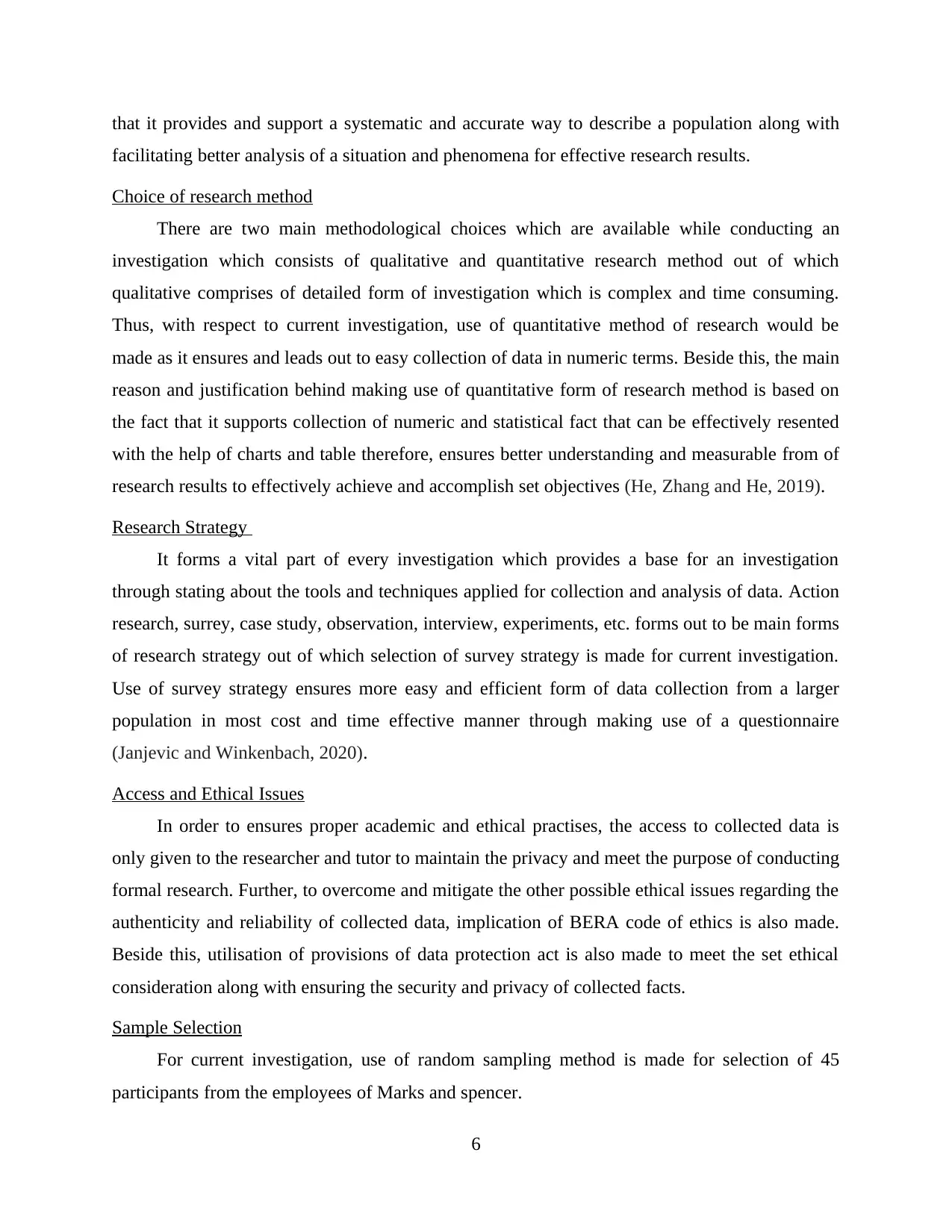
that it provides and support a systematic and accurate way to describe a population along with
facilitating better analysis of a situation and phenomena for effective research results.
Choice of research method
There are two main methodological choices which are available while conducting an
investigation which consists of qualitative and quantitative research method out of which
qualitative comprises of detailed form of investigation which is complex and time consuming.
Thus, with respect to current investigation, use of quantitative method of research would be
made as it ensures and leads out to easy collection of data in numeric terms. Beside this, the main
reason and justification behind making use of quantitative form of research method is based on
the fact that it supports collection of numeric and statistical fact that can be effectively resented
with the help of charts and table therefore, ensures better understanding and measurable from of
research results to effectively achieve and accomplish set objectives (He, Zhang and He, 2019).
Research Strategy
It forms a vital part of every investigation which provides a base for an investigation
through stating about the tools and techniques applied for collection and analysis of data. Action
research, surrey, case study, observation, interview, experiments, etc. forms out to be main forms
of research strategy out of which selection of survey strategy is made for current investigation.
Use of survey strategy ensures more easy and efficient form of data collection from a larger
population in most cost and time effective manner through making use of a questionnaire
(Janjevic and Winkenbach, 2020).
Access and Ethical Issues
In order to ensures proper academic and ethical practises, the access to collected data is
only given to the researcher and tutor to maintain the privacy and meet the purpose of conducting
formal research. Further, to overcome and mitigate the other possible ethical issues regarding the
authenticity and reliability of collected data, implication of BERA code of ethics is also made.
Beside this, utilisation of provisions of data protection act is also made to meet the set ethical
consideration along with ensuring the security and privacy of collected facts.
Sample Selection
For current investigation, use of random sampling method is made for selection of 45
participants from the employees of Marks and spencer.
6
facilitating better analysis of a situation and phenomena for effective research results.
Choice of research method
There are two main methodological choices which are available while conducting an
investigation which consists of qualitative and quantitative research method out of which
qualitative comprises of detailed form of investigation which is complex and time consuming.
Thus, with respect to current investigation, use of quantitative method of research would be
made as it ensures and leads out to easy collection of data in numeric terms. Beside this, the main
reason and justification behind making use of quantitative form of research method is based on
the fact that it supports collection of numeric and statistical fact that can be effectively resented
with the help of charts and table therefore, ensures better understanding and measurable from of
research results to effectively achieve and accomplish set objectives (He, Zhang and He, 2019).
Research Strategy
It forms a vital part of every investigation which provides a base for an investigation
through stating about the tools and techniques applied for collection and analysis of data. Action
research, surrey, case study, observation, interview, experiments, etc. forms out to be main forms
of research strategy out of which selection of survey strategy is made for current investigation.
Use of survey strategy ensures more easy and efficient form of data collection from a larger
population in most cost and time effective manner through making use of a questionnaire
(Janjevic and Winkenbach, 2020).
Access and Ethical Issues
In order to ensures proper academic and ethical practises, the access to collected data is
only given to the researcher and tutor to maintain the privacy and meet the purpose of conducting
formal research. Further, to overcome and mitigate the other possible ethical issues regarding the
authenticity and reliability of collected data, implication of BERA code of ethics is also made.
Beside this, utilisation of provisions of data protection act is also made to meet the set ethical
consideration along with ensuring the security and privacy of collected facts.
Sample Selection
For current investigation, use of random sampling method is made for selection of 45
participants from the employees of Marks and spencer.
6
⊘ This is a preview!⊘
Do you want full access?
Subscribe today to unlock all pages.

Trusted by 1+ million students worldwide
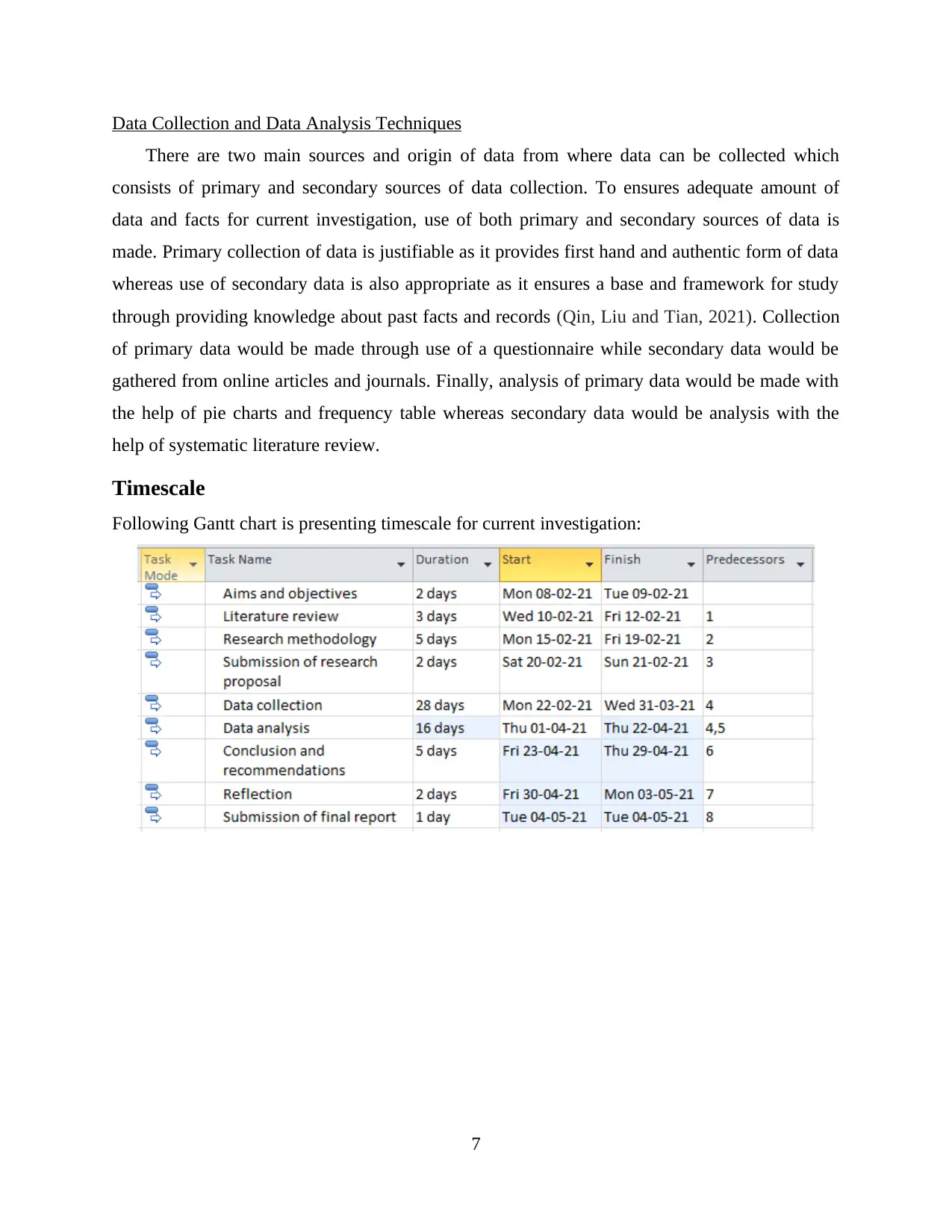
Data Collection and Data Analysis Techniques
There are two main sources and origin of data from where data can be collected which
consists of primary and secondary sources of data collection. To ensures adequate amount of
data and facts for current investigation, use of both primary and secondary sources of data is
made. Primary collection of data is justifiable as it provides first hand and authentic form of data
whereas use of secondary data is also appropriate as it ensures a base and framework for study
through providing knowledge about past facts and records (Qin, Liu and Tian, 2021). Collection
of primary data would be made through use of a questionnaire while secondary data would be
gathered from online articles and journals. Finally, analysis of primary data would be made with
the help of pie charts and frequency table whereas secondary data would be analysis with the
help of systematic literature review.
Timescale
Following Gantt chart is presenting timescale for current investigation:
7
There are two main sources and origin of data from where data can be collected which
consists of primary and secondary sources of data collection. To ensures adequate amount of
data and facts for current investigation, use of both primary and secondary sources of data is
made. Primary collection of data is justifiable as it provides first hand and authentic form of data
whereas use of secondary data is also appropriate as it ensures a base and framework for study
through providing knowledge about past facts and records (Qin, Liu and Tian, 2021). Collection
of primary data would be made through use of a questionnaire while secondary data would be
gathered from online articles and journals. Finally, analysis of primary data would be made with
the help of pie charts and frequency table whereas secondary data would be analysis with the
help of systematic literature review.
Timescale
Following Gantt chart is presenting timescale for current investigation:
7
Paraphrase This Document
Need a fresh take? Get an instant paraphrase of this document with our AI Paraphraser
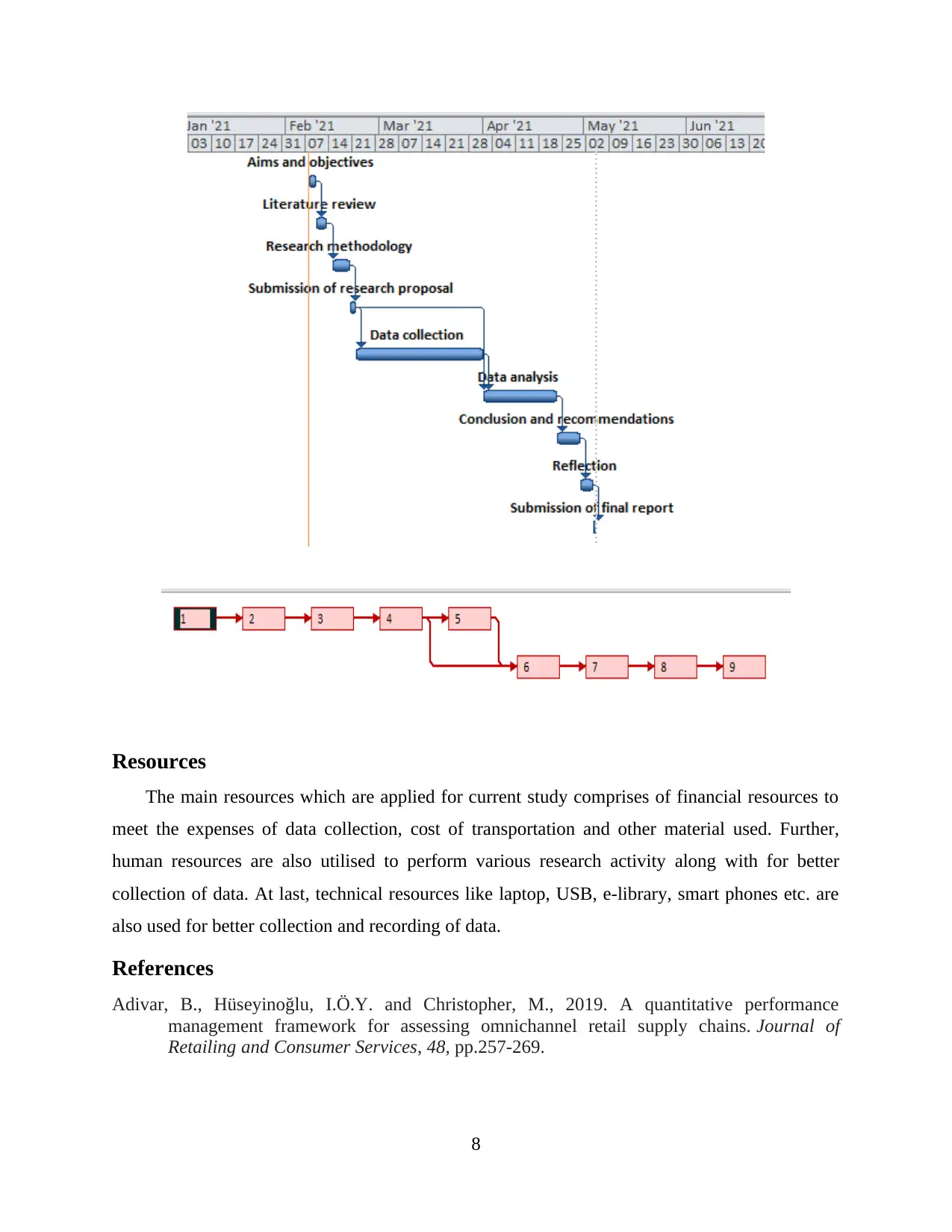
Resources
The main resources which are applied for current study comprises of financial resources to
meet the expenses of data collection, cost of transportation and other material used. Further,
human resources are also utilised to perform various research activity along with for better
collection of data. At last, technical resources like laptop, USB, e-library, smart phones etc. are
also used for better collection and recording of data.
References
Adivar, B., Hüseyinoğlu, I.Ö.Y. and Christopher, M., 2019. A quantitative performance
management framework for assessing omnichannel retail supply chains. Journal of
Retailing and Consumer Services, 48, pp.257-269.
8
The main resources which are applied for current study comprises of financial resources to
meet the expenses of data collection, cost of transportation and other material used. Further,
human resources are also utilised to perform various research activity along with for better
collection of data. At last, technical resources like laptop, USB, e-library, smart phones etc. are
also used for better collection and recording of data.
References
Adivar, B., Hüseyinoğlu, I.Ö.Y. and Christopher, M., 2019. A quantitative performance
management framework for assessing omnichannel retail supply chains. Journal of
Retailing and Consumer Services, 48, pp.257-269.
8
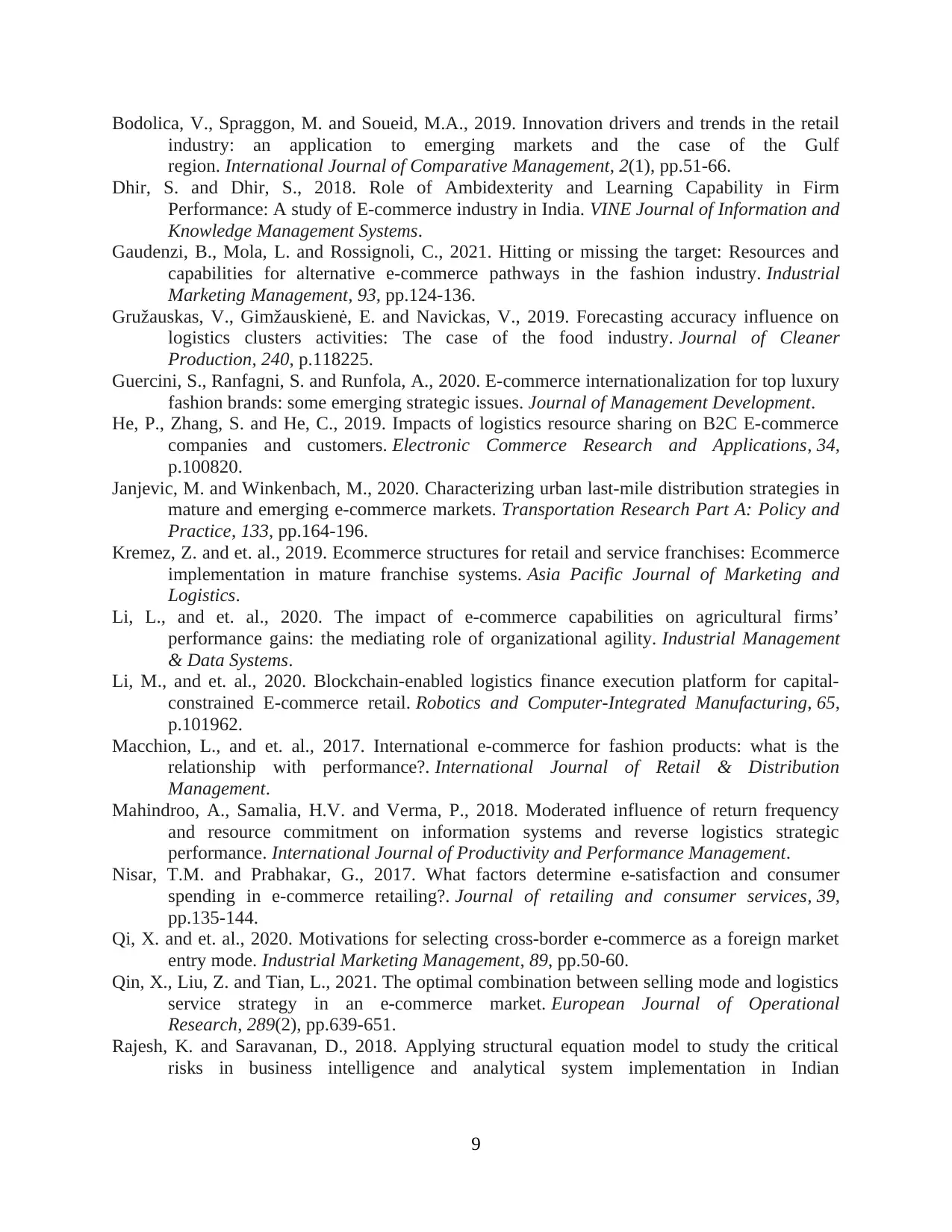
Bodolica, V., Spraggon, M. and Soueid, M.A., 2019. Innovation drivers and trends in the retail
industry: an application to emerging markets and the case of the Gulf
region. International Journal of Comparative Management, 2(1), pp.51-66.
Dhir, S. and Dhir, S., 2018. Role of Ambidexterity and Learning Capability in Firm
Performance: A study of E-commerce industry in India. VINE Journal of Information and
Knowledge Management Systems.
Gaudenzi, B., Mola, L. and Rossignoli, C., 2021. Hitting or missing the target: Resources and
capabilities for alternative e-commerce pathways in the fashion industry. Industrial
Marketing Management, 93, pp.124-136.
Gružauskas, V., Gimžauskienė, E. and Navickas, V., 2019. Forecasting accuracy influence on
logistics clusters activities: The case of the food industry. Journal of Cleaner
Production, 240, p.118225.
Guercini, S., Ranfagni, S. and Runfola, A., 2020. E-commerce internationalization for top luxury
fashion brands: some emerging strategic issues. Journal of Management Development.
He, P., Zhang, S. and He, C., 2019. Impacts of logistics resource sharing on B2C E-commerce
companies and customers. Electronic Commerce Research and Applications, 34,
p.100820.
Janjevic, M. and Winkenbach, M., 2020. Characterizing urban last-mile distribution strategies in
mature and emerging e-commerce markets. Transportation Research Part A: Policy and
Practice, 133, pp.164-196.
Kremez, Z. and et. al., 2019. Ecommerce structures for retail and service franchises: Ecommerce
implementation in mature franchise systems. Asia Pacific Journal of Marketing and
Logistics.
Li, L., and et. al., 2020. The impact of e-commerce capabilities on agricultural firms’
performance gains: the mediating role of organizational agility. Industrial Management
& Data Systems.
Li, M., and et. al., 2020. Blockchain-enabled logistics finance execution platform for capital-
constrained E-commerce retail. Robotics and Computer-Integrated Manufacturing, 65,
p.101962.
Macchion, L., and et. al., 2017. International e-commerce for fashion products: what is the
relationship with performance?. International Journal of Retail & Distribution
Management.
Mahindroo, A., Samalia, H.V. and Verma, P., 2018. Moderated influence of return frequency
and resource commitment on information systems and reverse logistics strategic
performance. International Journal of Productivity and Performance Management.
Nisar, T.M. and Prabhakar, G., 2017. What factors determine e-satisfaction and consumer
spending in e-commerce retailing?. Journal of retailing and consumer services, 39,
pp.135-144.
Qi, X. and et. al., 2020. Motivations for selecting cross-border e-commerce as a foreign market
entry mode. Industrial Marketing Management, 89, pp.50-60.
Qin, X., Liu, Z. and Tian, L., 2021. The optimal combination between selling mode and logistics
service strategy in an e-commerce market. European Journal of Operational
Research, 289(2), pp.639-651.
Rajesh, K. and Saravanan, D., 2018. Applying structural equation model to study the critical
risks in business intelligence and analytical system implementation in Indian
9
industry: an application to emerging markets and the case of the Gulf
region. International Journal of Comparative Management, 2(1), pp.51-66.
Dhir, S. and Dhir, S., 2018. Role of Ambidexterity and Learning Capability in Firm
Performance: A study of E-commerce industry in India. VINE Journal of Information and
Knowledge Management Systems.
Gaudenzi, B., Mola, L. and Rossignoli, C., 2021. Hitting or missing the target: Resources and
capabilities for alternative e-commerce pathways in the fashion industry. Industrial
Marketing Management, 93, pp.124-136.
Gružauskas, V., Gimžauskienė, E. and Navickas, V., 2019. Forecasting accuracy influence on
logistics clusters activities: The case of the food industry. Journal of Cleaner
Production, 240, p.118225.
Guercini, S., Ranfagni, S. and Runfola, A., 2020. E-commerce internationalization for top luxury
fashion brands: some emerging strategic issues. Journal of Management Development.
He, P., Zhang, S. and He, C., 2019. Impacts of logistics resource sharing on B2C E-commerce
companies and customers. Electronic Commerce Research and Applications, 34,
p.100820.
Janjevic, M. and Winkenbach, M., 2020. Characterizing urban last-mile distribution strategies in
mature and emerging e-commerce markets. Transportation Research Part A: Policy and
Practice, 133, pp.164-196.
Kremez, Z. and et. al., 2019. Ecommerce structures for retail and service franchises: Ecommerce
implementation in mature franchise systems. Asia Pacific Journal of Marketing and
Logistics.
Li, L., and et. al., 2020. The impact of e-commerce capabilities on agricultural firms’
performance gains: the mediating role of organizational agility. Industrial Management
& Data Systems.
Li, M., and et. al., 2020. Blockchain-enabled logistics finance execution platform for capital-
constrained E-commerce retail. Robotics and Computer-Integrated Manufacturing, 65,
p.101962.
Macchion, L., and et. al., 2017. International e-commerce for fashion products: what is the
relationship with performance?. International Journal of Retail & Distribution
Management.
Mahindroo, A., Samalia, H.V. and Verma, P., 2018. Moderated influence of return frequency
and resource commitment on information systems and reverse logistics strategic
performance. International Journal of Productivity and Performance Management.
Nisar, T.M. and Prabhakar, G., 2017. What factors determine e-satisfaction and consumer
spending in e-commerce retailing?. Journal of retailing and consumer services, 39,
pp.135-144.
Qi, X. and et. al., 2020. Motivations for selecting cross-border e-commerce as a foreign market
entry mode. Industrial Marketing Management, 89, pp.50-60.
Qin, X., Liu, Z. and Tian, L., 2021. The optimal combination between selling mode and logistics
service strategy in an e-commerce market. European Journal of Operational
Research, 289(2), pp.639-651.
Rajesh, K. and Saravanan, D., 2018. Applying structural equation model to study the critical
risks in business intelligence and analytical system implementation in Indian
9
⊘ This is a preview!⊘
Do you want full access?
Subscribe today to unlock all pages.

Trusted by 1+ million students worldwide
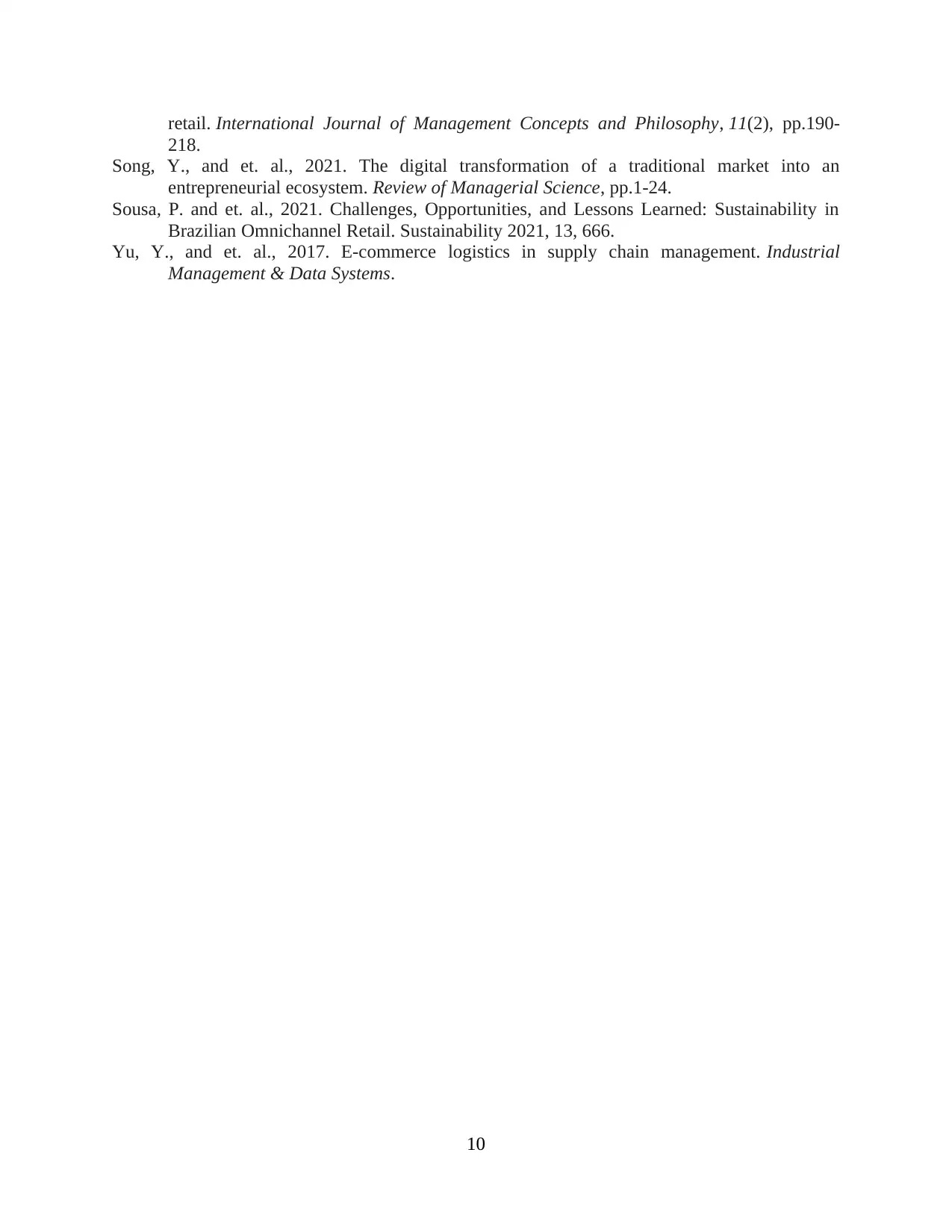
retail. International Journal of Management Concepts and Philosophy, 11(2), pp.190-
218.
Song, Y., and et. al., 2021. The digital transformation of a traditional market into an
entrepreneurial ecosystem. Review of Managerial Science, pp.1-24.
Sousa, P. and et. al., 2021. Challenges, Opportunities, and Lessons Learned: Sustainability in
Brazilian Omnichannel Retail. Sustainability 2021, 13, 666.
Yu, Y., and et. al., 2017. E-commerce logistics in supply chain management. Industrial
Management & Data Systems.
10
218.
Song, Y., and et. al., 2021. The digital transformation of a traditional market into an
entrepreneurial ecosystem. Review of Managerial Science, pp.1-24.
Sousa, P. and et. al., 2021. Challenges, Opportunities, and Lessons Learned: Sustainability in
Brazilian Omnichannel Retail. Sustainability 2021, 13, 666.
Yu, Y., and et. al., 2017. E-commerce logistics in supply chain management. Industrial
Management & Data Systems.
10
1 out of 10
Related Documents
Your All-in-One AI-Powered Toolkit for Academic Success.
+13062052269
info@desklib.com
Available 24*7 on WhatsApp / Email
![[object Object]](/_next/static/media/star-bottom.7253800d.svg)
Unlock your academic potential
Copyright © 2020–2025 A2Z Services. All Rights Reserved. Developed and managed by ZUCOL.





